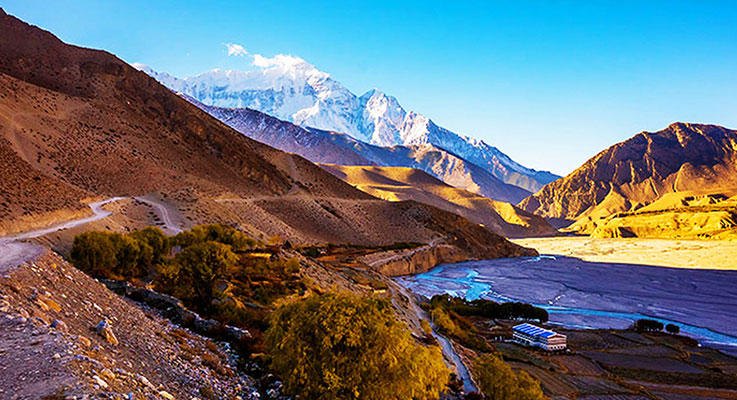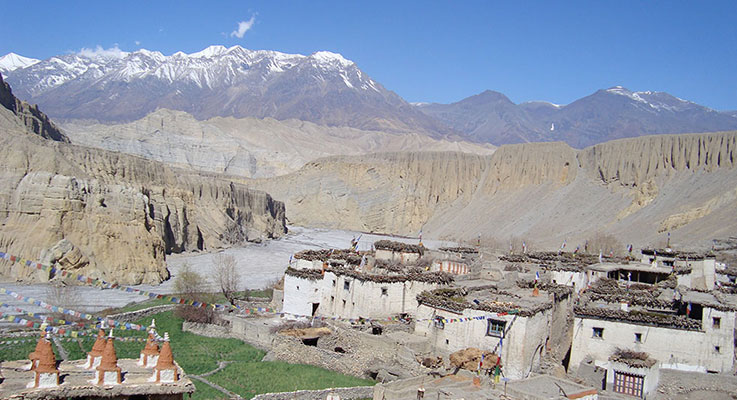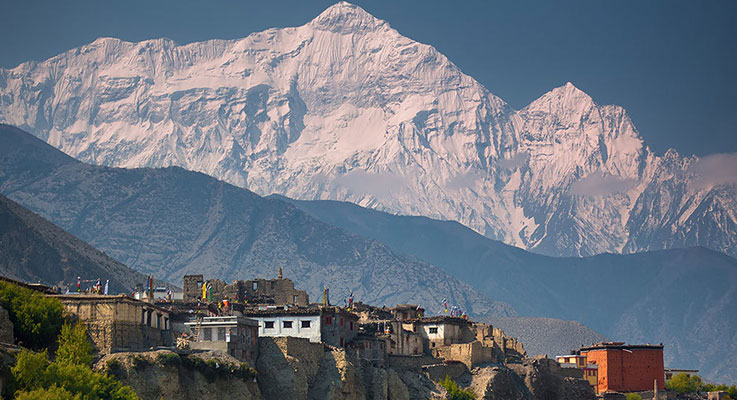-
Day 1
Arrival in Kathmandu (1,345m/4,413 ft)
Upon arriving at at Tribhuwan International Airport in Kathmandu, you will be received by our airport representatives who will warmly greet you and transfer to the hotel on a private tourist vehicle. We provide 3-star accommodation in the city and we arrange for a trip briefing with dinner in the evening.
-
Day 2
Visit old town of Kathmandu
A professional guide and vehicle are provided for a day of sightseeing in and around Kathmandu city. We visit some of the UNESCO World Heritage Sites in the city along with other interesting cultural monuments that dot the valley. These include Boudhanath Stupa (the largest Buddhist shrines in the world), Pashupatinath (the holiest Hindu temple in the world), Durbar Squares (Palaces and fortresses of medieval Kings), along with other popular cultural attractions. We get to observe the lifestyle of Nepalese people, holy sadhus and monks, fascinating history as well as awe-inspiring architecture.
-
Day 3
Drive from Kathmandu to Pokhara (900m/2,953 ft)
A fascinating and scenic 6-hour drive from Kathmandu takes us to the picturesque valley of Pokhara. On a clear day, views of Ganesh Himal, Himalchuli, Manaslu, Lamjung Himal, Annapurna will be seen from this lakeside city famous for Phewa Lake, Peace Pagoda and of course, the mountain views. We spend the afternoon in leisure and spend some time sightseeing in Pokhara.
-
Day 4
Fly from Pokhara to Jomsom (2,720m / 8,924ft). Trek to Marpha (2,670m / 8,760ft)
A spectacular early morning flight from Pokhara to Jomsom, flying up the Kali Gandaki River Valley directly between two of the highest 10 peaks in the world Dhaulagiri (26,811 ft)and Annapurna (26,504 ft). Jomsom is the administrative center for the Mustang District, and the change in scenery from lush Pokhara to this arid Trand Himalayan region is striking. After lunch hike to Marpha village visit a Buddhist Monastery and apple farms.
-
Day 5
Trek from Jomsom to Kagbeni (2,810m / 9,219ft)
We begin our trek here hiking up the gravel path to the valley of Kagbeni. This village is at the confluence of the Kali Gandaki and Jhong Khola coming down from Muktinath. The red-colored monastery belonging to the Shakya sect dominates this first of many Tibetan-style villages.
-
Day 6
Trek from Kagbeni to Chele (3,077m / 10,095ft)
There is a trail up the east bank of the Kali Gandaki that climbs over many ridges as it heads north. In the dry season, it is possible to trek the entire route up the river along the sand and gravel of the riverbed. Unlike most gompas in upper Mustang, gompa kang is of the Nyingmapa sect. the village of Tangbe is situated along side the east bank trail above the river at an elevation of 1990m. Here are the first of the black, white and red Chortens that typify upper Mustang. The town is a labyrinth of narrow alleys along white washed houses, fields of buckwheat, barley and wheat and apple orchards. Nilgiri peak, which dominates the southern skyline at Kagbeni, continues to loom t the foot of the valley. Chhuksang village is about 1.5 hours beyond Tangbe at the confluence of the Narshing khola and the Kali Gandaki at 2920m. There are three separate parts of this village and some broken castle walls on the surrounding cliffs. Up the Narshing Khola is the gompa and village of Tetang and a small salt mine. Across the river from Chhuksang are some spectacular red organ-pipe eroded cliffs above the mouths of inaccessible caves. The five villages in this area, Chele, ghayakar, Chhuksang, Tangbe and Tetang, are culturally unified groups of people who call themselves Gurungs and are ore closely related to the Manang is than to the Thakalis or Lobas. The trek now leaves the Kali Gandaki valley and climbs steeply up a rocky gully to Chele at 3030m. This is a small village that boasts upper Mustang's first hotel, the Nilgiri, and a hop among the extensive fields of wheat and barley that blanket the hillside.
-
Day 7
Trek from Chele to Shyangoche (3,900m / 12,795ft)
The climb from Chele is up a steep spur to a cairn at 3080m. Here there is a view of the village of Gayakar across a huge canyon. A long wall of packed earth encircles Ghyakar and its fields. The climb continues- a long, steep, treeless, waterless slog-along the side of the spectacular steep canyon to a pass and cairn at 3480m. Here the trail makes a long gradual descent to some Chortens on a ridge, then descends further on a pleasant trails to Samar, situated in a grove of poplar trees at 3290m his is a major stopping place for horse caravans. The Annapurna Himal, still dominated by Nilagiri, is visible far to the south. The trail climbs above Samar to ridge then descends into a large gorge past a Chorten painted in red, black, yellow and white-all pigments made from local rocks. The trails goes into another valley filled with juniper trees, crosses a stream and climbs up to a ridge at 3800m and drops to Bhena. The route skirts a gorge, climbs slightly to Yamda, then climbs over yet another pass, follows a ridge, then descends to Shyangochen, a tiny settlement with a few teashops at 3650m.
-
Day 8
Trek from Shyangoche to Charang (3,595m / 11,795ft)
Trail climbs gently from Shyangochen to a pass at 3700m and enters another huge east-west valley. There is a trail junction here. The left trail is the direct route to the Nyi La, by passing Gelling. Take the right fork and descend to gelling with its poplar trees and extensive fields of barley at 3,440m. From Gelling, there trail climbs gently through fields up the center the valley, passing above these settlements of Tama Gaon and its imposing Chorten. It rejoins the direct trail and then becomes an unrelenting climb across the head of the valley to the Nyi La at 3840m. This pass is the southern boundary of Lo itself. The descent from the Nyi La is gentle. The trail descends below the blue, gray and red cliffs across the valley to a steel bridge across the Tangmar Chhu River, then climbs past what is perhaps the longest and most spectacular stretch of Mani wall in Nepal. Climbing over another pass at 3770m, the route makes a long gentle descent to Charang at 3,490m.
-
Day 9
Trek from Charang to Lo Manthan (3,891m / 12,766ft)
Trail descends about 125m from Charang, crosses the Charang Chu and climbs steeply up a rocky trail to a cairn on a ridge opposite the village at 3530m, then enters the Tholung Valley. The trail turns north and climbs gently to a large isolated Chorten that marks the boundary between Charang and Lo. Still climbing, the trail crosses a stream, and then becomes a grand wide thoroughfare traveling across a desert like landscape painted in every hue of gray and yellow. Finally, from a ridge at 3,850m, there is a view of the walled city of Lo. A short descent leads onto the 'plain of aspiration' at 3,780m. The trail then crosses a stream and climbs up onto the plateau of Lo Manthang itself at 3730m. Crossing an irrigation canal at the southern wall of the city. The only entrance to the city is at the north-eastern corner, so circumambulate the wall to the gate where you are sure to find a group of adults and children playing, spinning wool and gossiping.
-
Day 10-11
Rest and exploration in Lo Manthan
There are four major temples within the city walls. Each of these buildings is locked. The villagers feel it necessary to control access to the temples; the caretaker and the key are available only at certain times, and usually only after a bit of negotiation. The tall Champa Lhakang (Lha Khang translates as 'god house') its said to date from the 1420s and is accessible only on the 2nd stories. The central courtyard with its carved wooden pillars has fallen into disrepair. Inside the temple is a huge painted clay statue of maitreya, the future Buddha, sitting on a pedestal that occupies the entire ground floor. The walls are painted with elaborate mandalas almost two meters in diameters that are in marginally better condition than the paintings in Thugchen Gompa. The red Thugchen Gompa is near the centre of the city, a massive assembly hall.
Supported by huge wooden columns dating from the same period as Champa Lhakang. Tucci observed that the same artists had painted frescoes in both temples. There are statues of the deities Shakyamuni surrounded by Avalokitesvara, Vaisravana (the god of wealth) and Padmasambhava. One wall of the temple is completely destroyed; on the other walls are intricate frescoes in various stages of deterioration. The entrance hall contains huge scowling statues of four Lokapala, the protectors of the cardinal points of the compass. The other two temples are within the monastic quarter, which is the domain of several large growling Tibetan mastiffs. Secure the services of a monk before you even attempt to enter this part of the city. The main temple is the Chyodi Gompa, which contains dozens of beautifully crafted small bronze, brass and copper statues, any said that have been cast in Lo Manthang itself. The monks prohibit taking photographs of these statues in an apparent effort to limit interest in them among collectors of stolen art. Nerby is the older assembly hall, which contains little more than the images of three Shakypa Lamas.
Raja's palace: the Raja's palace is an imposing four-story building in the center of the city. It is the home of the present raja, Jigme Parbal Bista, and the queen, or Rani, who is from an aristocratic family of Lasa. The raja is an active horseman and keeps a stable of the best horses in Lo. He also breeds Lhasa apso dogs and several monstrous Tibetan mastiffs that can be heard barking angrily in the 2nd story of the palace. Though his duties are largely cerenial, he is respected by the people and consulted about many issues by villagers throughout Lo.
-
Day 12
Trek from Lo Manthan to Lo Gekar (3,522m / 11,555ft)
The trail to Lo Gekar is not a main trading route and the area is crisscrossed with herders' trails, so a local guide is particularly useful here. The trail climbs steadily to a pass marked by a cairn, offering a last glimpse of Lo Manthang. The trail contours across the head of a valley and crosses another ridge, then drop into another large desolate valley. After descending to the valley floor, the route heads to the west up the center of the valley to its head. Cross a ridge at 4070m. And traverse across the heads of two ore valleys to an indistinct pass. Cross the pass to some meadows and a stream. The trail then makes a long rocky descent down a ravine to the settlement of Lo Gekar (which means 'pure virtue of Lo'), then reaches a grassy valley where Ghar Gompa is situated in a grove of large trees alongside a stream. Ghar Gompa means house temple and is so-named because the structure is built like a house with small separate rooms. The gompa is decorated with paintings and statues and several large prayer wheels. The primary deities are placed on a brass altar inside a dark alcove; on one wall of the alcove there is a self-emanating statue. The real treasure of Ghar Gopmpa is the hundreds of painted carved stones displayed on the walls in wooden frames.
-
Day 13
Trek from Lo Gekar to Tama Gaon/Gelling (3,571m / 11,716ft)
Climb to a ridge, then across a valley to a cairn and a pass 200m. above Ghar Gompa. The route crosses some alpine eroded gully to the upper part of the village of Dhakmar, whose name means 'red crag'. A large stream meanders through this village, making this a particularly pretty valley. Most of the surrounding hills are pastel shades of grey and yellow, but a huge, red, fluted cliff provides a dramatic contrast. The trail descends alongside the stone walls and fields of the extensive village, then climbs to a ridge. It is a short descent to Ghami at 3460m. from Ghami, follow the direct route to the Nyi La, climbing to a cairn on a ridge and then contouring upwards to meet the trail from Charang. Continue to the pass and descend steeply into the Gelling Valley. Follow the trail that by passes Gelling to an isolated teahouse and descends gently to Tama Gaon.
-
Day 14
Trek from Tama Gaon to Chusang (2,966m / 9,731ft)
A steep set of switchbacks leads to a stream, then the trail climbs to a huge painted Chorten before rejoining the Gelling trail near the ridge, just below a Chorten. The reminder of the day is on already traveled trails back to Chusang.
-
Day 15
Trek from Chusang to Kagbeni (2,810m / 9,219ft)
Retrace the upward trail back to the Kali Gandaki and downstream to Kagbeni.
-
Day 16
Trek from Kagbeni to Jomsom (2,720m / 8,924ft)
-
Day 18
Free day at Pokhara
This is a free day at Pokhara for relaxation and reflection of the wonderful trip we’ll have successfully completed. It is also a contingency day in case of flight cancellation to Pokhara. In the lakeside city, there is a ton of amazing activities you could try including paragliding, microlight and zipliner among others. You may also go sightseeing at various places of interests like Gupteshwar Caves, museums, Davis Falls, etc.
-
Day 19
Fly from Pokhara to Kathmandu and leisure day
We catch a flight from Pokhara to Kathmandu. The short flight takes us over the hills and mountains that glisten below. Once we reach Kathmandu, the rest of the day will be leisure and free for exploration. You are free to go souvenir shopping, spa and more exploration of the city, or extend your trip to include bungee jumping, rafting, mountain biking, Everest mountain flight and other adventurous activities. In the evening, we will have a farewell dinner at Mul Chowk Restaurant’s cozy and elegant dining ambience.
-
Day 20
Departure from Nepal
The trip concludes today. You will be dropped at Kathmandu's Tribhuwan International Airport by our airport representative for your flight departure from Nepal.



